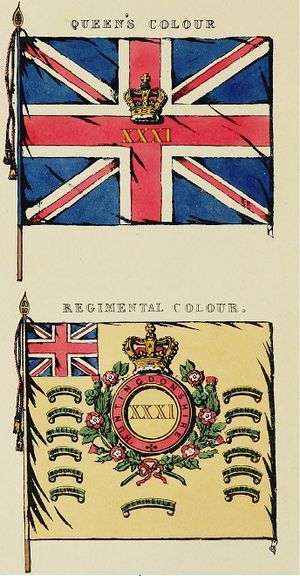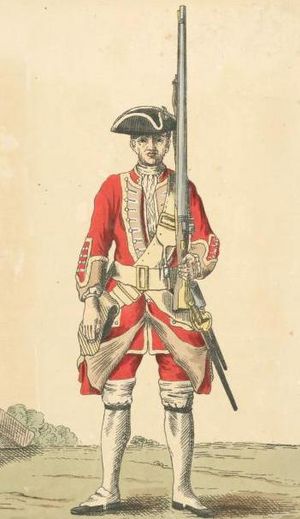31st (Huntingdonshire) Regiment of Foot facts for kids
Quick facts for kids 31st (Huntingdonshire) Regiment of Foot |
|
|---|---|

Colours of the 31st (Huntingdonshire) Regiment of Foot
|
|
| Active | 1702–1881 |
| Country |
|
| Allegiance | |
| Type | Infantry |
| Garrison/HQ | The Barracks, Kingston upon Thames |
| Nickname(s) | The Young Buffs |
| Colors | Buff facings |
| Engagements | War of the Austrian Succession American Revolutionary War Peninsular War First Anglo-Afghan War Crimean War |
The 31st (Huntingdonshire) Regiment of Foot was a special group of soldiers in the British Army. They were like a team of foot soldiers, first formed way back in 1702. For many years, they fought in different wars and helped protect the country. In 1881, this regiment joined up with another group, the 70th (Surrey) Regiment of Foot, to create a new, bigger regiment called the East Surrey Regiment.
Contents
History of the Regiment
How it Started
The story of the 31st Regiment began in 1694 during a war called the Nine Years' War. A man named Sir Richard Atkins was given permission to create a group of foot soldiers to serve in Ireland. This group was first known as Sir Richard Atkins's Regiment of Foot. A few years later, in 1697, the war ended, and the regiment was disbanded, meaning it was closed down.
But in 1702, England was involved in another big European conflict, the War of the Spanish Succession. George Villiers was asked to bring his regiment back together, but this time as marines, who are soldiers trained to fight on land and sea. So, they became George Villier's Regiment of Marines.
This marine regiment helped capture and defend Gibraltar in 1704. They also fought in other battles in Spain and the Mediterranean Sea, like capturing Barcelona and Majorca. The regiment's name changed a few times depending on who was leading it.
When the war ended in 1713, most marine regiments were disbanded. However, Villiers's Marines were kept and became regular foot soldiers. They were then known as the 31st Regiment of Foot. They helped stop the Jacobite rising of 1715, a rebellion in Britain. After that, they spent 26 years guarding places in Ireland and England.
The "Young Buffs" Nickname
In 1742, the regiment went to a place called Flanders to fight in the War of the Austrian Succession. They took part in the Battle of Dettingen in June 1743. It was during this battle that they got their famous nickname, "Young Buffs."
King George II was leading the soldiers and saw the 31st Regiment fighting bravely. He thought they were the 3rd Regiment of Foot, who were known as "the Buffs" because of their buff-colored uniforms. The King shouted, "Bravo, Buffs! Bravo!" When an officer corrected him, the King then cheered, "Bravo, Young Buffs! Bravo!" And so, the nickname stuck!
The regiment also fought in the Battle of Fontenoy in 1745, where they lost many soldiers, and the Battle of Melle. They returned to England later that year.
In 1751, a new rule said that regiments should be known by their number, not by their leader's name. So, they officially became the 31st Regiment of Foot. In 1756, they formed a second group of soldiers, which later became the 70th (Surrey) Regiment of Foot. The regiment then went to Pensacola, Florida, but many soldiers got sick there. They later moved to Saint Vincent (Antilles) and returned to England in 1774.
Fighting in America
In May 1776, the regiment sailed to Quebec to fight in the American War of Independence. They were part of the Siege of Fort Ticonderoga (1777) in 1777. However, many of their soldiers were captured during the Battles of Saratoga later that year.
In 1782, regiments without a special royal name were given a county name. That's when they became the 31st (Huntingdonshire) Regiment of Foot. After the war, they stayed in Quebec for a while before returning to England in 1787. They even helped stop some riots in Birmingham in 1791.
Wars with France
The regiment was involved in many battles during the French Revolutionary and Napoleonic Wars. They helped capture Martinique in 1794, Guadeloupe in 1794, and Saint Lucia in 1796. Sadly, many soldiers got sick and died from fever during these campaigns. They also fought in the Battle of Alkmaar (1799) in Holland in 1799.
A second group of soldiers (2nd Battalion) was formed in 1805. This group fought in the Alexandria expedition of 1807. The first group (1st Battalion) was in Sicily in 1813 and later helped in the Siege of Genoa (1814) in Italy.
The 2nd Battalion went to Portugal in 1808. They joined Arthur Wellesley (who later became a famous general) in Spain. They fought bravely in the Battle of Talavera in July 1809, where they suffered many losses.
They also took part in other important battles like the Battle of Albuera in 1811, the Battle of Vitoria in 1813, and the Battle of Nivelle and Battle of Orthez in 1813-1814. In 1814, the second battalion was disbanded, and the regiment became a single group again.

The Burning of the Kent
In 1824, the regiment was ordered to go to India. On March 1, 1825, a terrible event happened. Their ship, the Kent, caught fire in the Bay of Biscay. Fifty-four soldiers, one woman, and 20 children connected to the regiment died.
However, many others were rescued! About 20 officers, 344 soldiers, 43 women, and 66 children were saved. Even in such a dangerous situation, the soldiers showed incredible bravery and discipline.
Later, in 1839, the First Anglo-Afghan War began. The regiment moved to Afghanistan and fought in the Battle of Kabul (1842) in 1842.
Later Years
The regiment returned to India in 1840. When the First Anglo-Sikh War started in 1845, they were part of the British forces. They fought in several battles, including the Battle of Mudki, Battle of Ferozeshah, Battle of Aliwal, and Battle of Sobraon.
In 1854, the regiment sailed to the Crimea and fought in the Siege of Sevastopol (1854–55). They also saw action in China during the Second Opium War in 1860, helping to capture the Taku Forts. They stayed in China until 1863 and helped stop the Taiping Rebellion.
For the rest of its time as a separate regiment, the 31st was stationed in various places like the United Kingdom, Gibraltar, and Malta.
In the 1870s, there were big changes in the British Army called the Cardwell Reforms. The 31st Regiment was linked with the 70th (Surrey) Regiment of Foot. Finally, on July 1, 1881, under the Childers Reforms, the 31st Regiment officially joined with the 70th Regiment to form the new East Surrey Regiment. It was a full circle moment, as the 70th Regiment had originally been formed from the 31st Regiment's second battalion back in 1756!
Battle Honours
The regiment was given special honors for its bravery in these battles:
|
|
Two more honors were given to the new East Surrey Regiment to remember the 31st Regiment's service: "Dettingen" (in 1882) and "Gibraltar 1704–1705" (in 1909).
Images for kids




